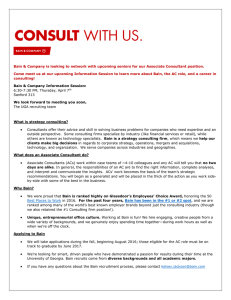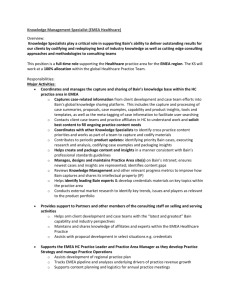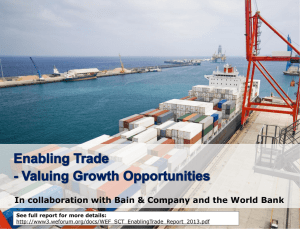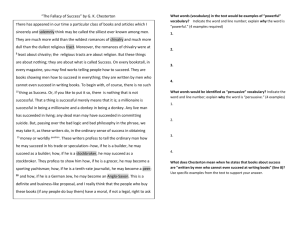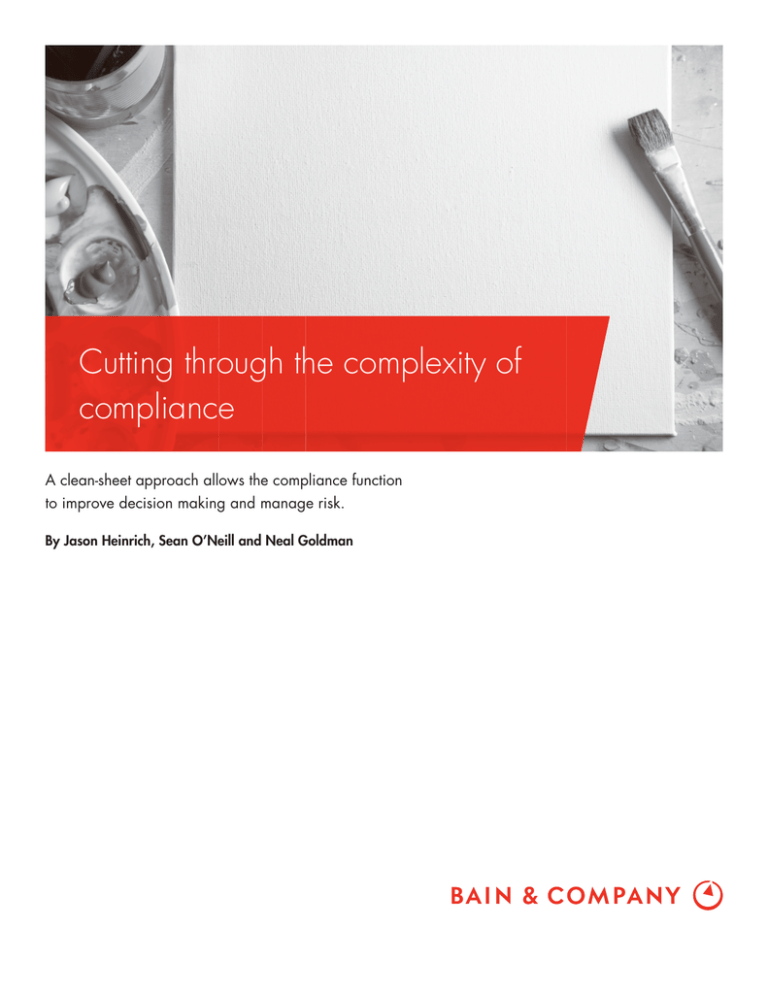
Cutting through the complexity of
compliance
A clean-sheet approach allows the compliance function
to improve decision making and manage risk.
By Jason Heinrich, Sean O’Neill and Neal Goldman
Jason Heinrich is a partner with Bain & Company’s Financial Services and
Performance Improvement practices. Sean O’Neill is a partner with the Financial
Services practice. Both are based in Chicago. Neal Goldman is a legal management adviser to Bain. The authors thank Andrea Eschmeyer, a Bain principal,
for her contributions to this publication.
Copyright © 2015 Bain & Company, Inc. All rights reserved.
Cutting through the complexity of compliance
When a US-based transaction processing company decided
to upgrade its know-your-customer (KYC) process for a
rollout in 50 countries, it devised a system and risk-based
sequence that would appease regulators in each country,
rein in costs, and yet also deliver a convenient, easy experience for customers.
management breakdowns. Failures at large, multifaceted
organizations such as Lehman Brothers, the Irish banks
and AIG resulted from some combination of inadequate coordination, process breakdowns, outdated policies and systems, and unclear decision processes. The
rise of Big Data is adding to the challenge: Putting more
data into bad processes and poor decision architectures
clogs the system until it breaks down.
A major Canadian bank aspired to design a best-in-class
anti-fraud experience for customers while also improving
employee engagement and the economics of its antifraud
system. To do this, it assembled a cross-functional team
that could design the experience, improve the bank’s
capabilities and accelerate initial tests before rolling out
the new experience across the bank network.
System failures have led to major financial penalties for
companies and their executives (see Figure 1). Since
2009, more than 190 companies have entered into
agreements with the US Department of Justice, paying
$30 billion in fines. Late in 2014, the US Financial
Crimes Enforcement Network filed charges seeking a
$1 million penalty against the former chief compliance
officer (CCO) of MoneyGram International for failure
to stop money laundering activities. Similar regulatory
trends are occurring around the world, particularly in
Europe and increasingly in Asia. The damage in reputation, lost customers and loss of shareholder value can
be even more severe.
The common thread for these initiatives? Risk and Compliance partnered with the lines of business not only to
ensure that the firm fulfilled legal requirements but
also to enhance the customer experience.
Organizational complexity, more than
a few rogue employees, lies at the
heart of recent compliance and risk
management breakdowns.
Moreover, disparate systems, often the result of incomplete integration after mergers and acquisitions, make
compliance and risk management more difficult. As
new regulatory efforts, such as the Office of the Comptroller of the Currency’s Standard on Heightened Expectations, require these processes to function well, quickly
reconciling the gaps has become a more urgent challenge.
Financial services companies face unprecedented complexity in their regulatory and risk environments. Moreover, the businesses themselves have become harder to
manage as technology and competitors move ever faster.
With the proliferation of digital channels and greater
customer involvement in core activities such as remote
deposit capture, compliance processes designed for physical locations have had to be reworked to handle “invisible” customers operating remotely. Many third parties
also get involved in this omnichannel ecosystem, and
problems can occur at any node on the network.
In our experience working with financial services companies around the world, and validated by various surveys, compliance has become a top priority for management and boards. Compliance department budgets
generally are growing faster than other functions.
JPMorgan Chase, for instance, spent about $2 billion
on compliance in 2014, roughly double the amount
from the previous year. Yet in some cases, the higher
spending focuses on short-term fixes that may introduce
further complexity.
Organizational complexity, more than a few rogue employees, lies at the heart of recent compliance and risk
How can the chief compliance officer (CCO), chief risk
officer (CRO) and team satisfy the demands of more
1
Cutting through the complexity of compliance
Figure 1: Financial services fines generally have been rising
Number of NPAs and DPAs entered into by US Department of Justice
40
Monetary recoveries related to NPAs and DPAs
40
39
$10B
38
34
8
30
30
28
24
6
21
20
19
4
14
10
8
2
6
2
3
2
0
0
01 02 03 04 05 06 07 08 09 10 11 12 13 14
2000 01 02 03 04 05 06 07 08 09 10 11 12 13 14
2000
Source: Gibson Dunn, 2014 Year-End Update on Corporate Non-Prosecution Agreements (NPAs) and Deferred Prosecution Agreements (DPAs), January 6, 2015.
and then pinpoints those tasks that could be eliminated
altogether to reduce complexity and lower the risk of
system failure. The greater a company’s aspirations, the
deeper the structural changes required.
complex regulations while also helping their companies
grow their top and bottom lines? Unless financial services companies chart a clear compliance strategy and
investment roadmap that’s tightly linked to business
objectives, compliance work remains tactical and reactive, and may itself increase organizational complexity,
paradoxically increasing risk. (See the sidebar on page
3, “10 signs that you should consider a clean-sheet assessment of the compliance program.”)
For instance, many banks’ manual controls have to be
tested multiple times to comply with multiple regulatory frameworks, such as Basel, Sarbanes-Oxley, Comprehensive Capital Analysis and Review. In addition,
operational risk assessments, compliance risk assessments, internal testing and internal audits all review
the same controls repeatedly. Multiple reviews that never
become fully integrated invite the spread of inconsistent
conclusions and plans. A clean-sheet approach can build
the right solution the first time, eliminating redundancy
and cost and lowering risk.
A clean-sheet approach to business activities
The best-performing companies are fully reexamining
which compliance and risk management activities
they perform and how they are performed—not just
within the Risk and Compliance departments but across
the seams of the organization. This clean-sheet approach,
also called zero-basing, looks to identify the activities
that truly need to occur, who should do them, how
they should be executed to enhance decision making,
The transaction-processing company mentioned
earlier, for example, used this approach to reduce its
total compliance-related budget by over 20%, while
2
Cutting through the complexity of compliance
10 signs that you should consider a clean-sheet assessment of the compliance program
1. Frequent compliance breaches and failed audits, exams, government inquiries, litigation
2. Weak culture of compliance and excessive risk taking
3. Unclear roles and responsibilities
4. CCO without a consistent seat at the strategy table
5. Failure to make compliance part of the performance management system
6. Under-budgeting of compliance-related spending, as compliance costs and issues both increase
7. Cumbersome policies, procedures and processes in lieu of clear principles
8. Poor experience for customers who hit compliance queues
9. Limited automation, outsourcing or low-cost locations
10. Inconsistent assessment of risk in strategic transactions and significant business deals
greatly improving effectiveness and reducing risk. The
savings and risk mitigation came from eliminating or
reducing non-critical work, aligning controls with risks
and improved planning and execution. The gains in
effectiveness came from working closely with the business units to improve compliance while enhancing the
customer experience. For instance, the company tested
the new KYC process with customers, listened to the
feedback, and made adjustments to features—such as
text messaging at the point of sale—until customers
perceived the process as easy and convenient. That
helped to earn customers’ trust and loyalty.
ating model and key capabilities essential to making
the system work (see Figure 2).
New roles in an ensemble cast
CCOs generally play three roles: adviser to the business,
reviewer of key policies and processes performed by
others to ensure efficacy, and operator of critical compliance activities. In most financial regulatory regimes,
the business unit is the first line of defense and Compliance the second line.
But because Compliance touches so many parts of the
organization, from customer-facing front lines to backend IT, CCOs have a big opportunity to strengthen their
partnership with the business. One CCO, for instance,
Leading financial services firms have embraced the cleansheet mentality and redesigned four critical elements
of compliance: its roles, policies and priorities, oper-
3
Cutting through the complexity of compliance
Figure 2: High-performing compliance organizations focus on four key elements
Role of compliance
Clear principles and
metrics that support
this role
Aligned with regulations,
business strategy and
enterprise risk appetite
Enablers: People, processes, systems
Right leadership
skills, with strong
performance
management
Effective, efficient
end-to-end processes, enabled
by technology
Activities delivered
out of most
effective, lowestcost environment
Policies, programs and priorities
World-class
compliance
program
Risk-based policies
and standards
Well-defined and
prioritized activities
Cross-functional operating model
Clear roles,
decisions and
accountabilities
Supporting
structure and
organization
design
Governance,
monitoring and
oversight
Ways of working
and a culture
of doing the
right thing
Source: Bain & Company
runs a substantial fraud call center, which requires strong
general management skills beyond his legal and regulatory expertise. And anti-money-laundering (AML)
processes often give CCOs immediate access to troves
of customer information that can potentially influence
how a financial institution makes new growth investments.
of customer data collection processes or into a comprehensive customer data infrastructure that can support
Compliance, Marketing, Risk, and the lines of business. In most cases, KYC and AML are handled in a
completely different fashion than customer relationship management databases, marketing data warehouses
and other processes.
At many leading companies, CCOs have taken a more
active role in supporting growth and managing risks.
They spend more time with business leaders, to build
trust and devise solutions. That partnership allows the
Compliance function to do its job in a way that does
not break the business but rather, when done right, provides information that’s extremely useful in advancing
the business.
Instead of operating discrete processes that only capture
one component of the bigger picture, banks can design
efficient processes to enhance customer data up front
to meet all these needs. And Compliance has an integral
role in doing so.
With policies and programs, less can do more
Although laws require financial firms to have effective
compliance programs, the activities that define a firm’s
program should be customized based on its unique situation, including the underlying risks, organization,
Data management is one area that offers an opportunity
for greater collaboration between Compliance and other
parts of the business. Many banks have not fully integrated their KYC or AML processes into a broader set
4
Cutting through the complexity of compliance
products and customers. Compliance departments
can collect the universe of regulatory requirements
and use a risk assessment to define the policies and
activities that work best for each part of the organization.
Embedding compliance reviews at the right decision
points and in the right departments can reduce costs
and streamline decision making, adding value beyond
risk avoidance.
mentality and a proliferation of sub-optimal decisions.
While this conservative approach might boost compliance with regulations, it can strangle the business and
discourage employees. It’s easy to add rules, but harder
to remove them. Leading companies increasingly understand that “less can be more”; fewer policies with
strong statements of principle and a culture of doing the
right thing may well trump tomes of policies and procedures. This is where the CCO can manage compliance
in a way that streamlines business processes.
Taking a clean-sheet perspective, Compliance can establish a set of principles and a baseline of clear minimum
standards that give the organization flexibility to create
bespoke policies commensurate with the risks involved.
For instance, money services businesses may have high
AML risk and low politically exposed person (PEP) risk,
given the nature of their customer base. A private wealth
firm may have a high risk for PEPs and lower AML risk.
The specific risk profile guides the organization in determining where to invest its resources and how to size
compliance activities appropriately.
Consider how a Canadian pension fund governs the
information flow between its trading floor and private
investing groups. To ensure that investment professionals
don’t share proprietary information with traders, the
pension fund relies on its strong code of conduct and
culture of doing the right thing. That’s allowed the fund
to maintain a strong compliance track record with minimal governance complexity.
Redesigning the operating model
An operating model serves as a blueprint for the way
resources are organized and operated. Effective models
encompass several elements:
Fewer policies with strong statements
of principle and a culture of doing the
right thing may well trump tomes of
policies and procedures.
At one US financial services firm, hundreds of new,
often redundant, business rules were stacked on top
of each other over the years. The web of unclear rules
led to a rise in the number of blocked or held transactions, which in turn prompted more manual reviews
and diminished the customer experience. By zero-basing
these rules, the firm was able to untangle the mess and
deliver a more efficient and customer-friendly outcome.
The most aggressive or stringent policies won’t be suitable for every checkpoint. A stance of “more policies
equal more risk mitigation” creates a zero-tolerance
5
•
Strong governance
•
Decisions around the shape and size of the compliance function
•
Where to draw the boundaries between the compliance function and the lines of business
•
How people work together within and across
these boundaries
•
How the compliance function will add value to the
business units
•
How to integrate compliance into the business
•
What norms and behaviors should be encouraged
•
How conflict will be resolved
Cutting through the complexity of compliance
This blueprint of enhanced decision making, with the
right level of compliance embedded in the system,
serves as the core of an effective cross-functional compliance program.
the central group and functional areas reduced the risk
of items falling through the cracks.
Designing a compliance-focused operating model starts
by fully describing the compliance strategy requirements
to the senior executive team. Then that team must
agree on a compliance strategy. That allows the CCO’s
team, together with the business leaders, to create a
detailed plant that articulates the activities and priorities
required to execute that strategy. It may take some debate
among the senior team to agree on the priorities, but
that discussion is essential, otherwise the execution will
fail. This effort sets the framework for employees to
have a clear sense of their compliance-related accountabilities as well as an understanding of expected behaviors and ways of working.
Several factors have heightened the need for operating
models to evolve. The pursuit of growth has led to organizational complexity as financial services companies
extend to new customer segments, products and geographies. Financial institutions have also added staff
and made large technology investments to address
gaps exposed by the financial crisis, actions that potentially add complexity.
In addition, digital technology has changed every aspect
of business operations, including how and where companies interact with customers. Although Big Data analysis can provide valuable new insights, the growing volume of data can drown an unprepared enterprise.
IT systems must ensure that relevant, actionable data
gets to the right Compliance and business managers.
The right people with the right tools
All of the elements discussed so far—roles, policies, the
operating model—hinge on having employees with
the right skills, training, incentives and tools to implement them. For a more integrated approach to compliance, firms need to complement traditional subject
matter expertise in areas such as consumer protection,
trading rules and corruption with strong communication
and general business skills to get things done across
the organization.
For a more integrated approach to compliance, firms need to complement traditional subject matter expertise in areas
such as consumer protection, trading rules
and corruption with strong communication
and general business skills to get things
done across the organization.
The CCO is on point to recruit other talented business
people who can improve operational performance,
build trust and enhance collaboration with the business,
and also reduce some of the administrative burden on
the CCO. The CCO also has to champion the Compliance function and gain the stature of a trusted senior
adviser to the CEO and board, demonstrating business
acumen beyond compliance. To that end, CCOs, particularly in larger organizations, should aim to create or
amplify a few key capabilities to complement the regulatory subject matter experts:
Breakdowns in compliance typically result from process
deficiencies where well-meaning managers make bad
decisions or fail to recognize or escalate high-risk issues.
The right processes with clear accountabilities, decision
making, and reporting can greatly help. At the Canadian
pension fund mentioned previously, clarifying and documenting the compliance accountabilities that spanned
•
6
An operations officer who can play a meaningful
role in sponsoring significant change, like zero-based
budgeting, and make it stick. Good candidates
Cutting through the complexity of compliance
could come from within Compliance or outside;
the main criteria are an understanding of compliance perspectives and strong operational and general
management skills, including familiarity with
lean techniques.
•
•
A dedicated IT liaison familiar with compliance
issues and processes. He or she can help the IT staff
keep up with trends in areas like consumer protection and ensure that the right information is
collected accurately and cost-effectively. A liaison
can also help Compliance identify opportunities to
better use technology, sequence IT requests, and
evaluate specific solutions for purchase.
•
Data analytics personnel, particularly in transaction-heavy businesses, serve to identify and substantiate the risk-based approach.
•
HR and talent development personnel can help hire
and develop middle managers who have excellent
coaching and general management skills required
to make the desired changes happen.
Besides the right mix of talent, companies’ performance
metrics and incentives should encourage people to do
the right things (see Figure 3). Reward systems must
establish firmly that not every deal or sale is a good one.
For example, in countries where bribery or corruption
are pervasive, companies must confirm that they have
the appropriate safeguards to operate in such high-risk
environments, even if it means walking away from a
short-term revenue opportunity.
Embedded finance or other analytical personnel can
help illuminate spending patterns, workforce modeling and scorecard and metrics management—
all of which should come with clear returns. This
role should also help to ensure that business cases
and new opportunities fully reflect compliance costs.
Compared with simply adding headcount, a smarter
deployment of technology and lean method will help
raise the effectiveness of the Compliance function at a
Figure 3: Strong performance management helps to promote accountability
Area
Customers
Effectiveness
Metrics
Customer loyalty scores
>X%
“Know your customer” completion rates
>X%
Reduction in fraud incidents and corresponding complaints
X
Number of regulatory violations and material exam findings
X
Look-back and remediation project costs and associated penalties
Adherence to policies and procedures
Efficiency
$X
X
Reduction in reimbursements for fraud incidents
$X
Cost per transaction for compliance
$X
Average time between opening and closing an investigation case
Number of transactions requiring manual review
Cost per “know your customer” diligence
Partnership
Target
X minutes
X
$X
Employee training feedback
X
Feedback from business and operational leaders
X
Source: Bain & Company
7
Cutting through the complexity of compliance
Figure 4: Technology will dramatically change how compliance is delivered
Current state
Future state
Customer identity management
Transaction-based customers
Single customer record
Customer data management
Data collection
Data collection, validation and verification
Customer interactions
Multichannel
Omnichannel
Customer and transaction monitoring
Rigid, binary rules
Sophisticated risk modeling and assessment
Transaction intervention
Manual, lengthy intervention process
Automated, efficient intervention process
Customer communication
Reactive communication
Proactive communication
Front- and back-end processes
Paper-based processes
Digital processes
Investigation effectiveness
Fragmented case intelligence
Unified case intelligence
Disposition efficiencies
Limited decision automation
Sophisticated decision automation
Source: Bain & Company
lower cost (see Figure 4 ). Technology can identify
high-risk patterns of behavior that currently require
manual intervention. That will greatly reduce human
error and free up more time for Compliance officers
to focus on other high-value activities. Regulatory changes
heighten the need to accelerate initiatives that digitize
more information and processes. Banks that can provide
real-time access to data, for instance, will become more
transparent to regulators.
top talent, not average project managers, from across
the businesses who have the diplomatic skills to guide
the effort. When properly staffed, the transformation
office can serve as a catalyst to facilitate internal discussions about sensitive issues such as revenue at risk.
Done right, integrating Compliance as a close but independent partner with other functions and the business
units will reduce complexity, improve decision making,
build trust with customers and business partners and foster
a culture of integrity where top talent wants to work.
Organizing for success
Adopting an end-to-end compliance program that’s
embedded at just the right process points and adds the
least possible friction to the system entails a lot of change
across the whole enterprise. It typically benefits from
a cross-functional transformation office composed of
8
Shared Ambit ion, True Results
Bain & Company is the management consulting firm that the world’s business leaders come
to when they want results.
Bain advises clients on strategy, operations, technology, organization, private equity and mergers and acquisitions.
We develop practical, customized insights that clients act on and transfer skills that make change stick. Founded
in 1973, Bain has 51 offices in 33 countries, and our deep expertise and client roster cross every industry and
economic sector. Our clients have outperformed the stock market 4 to 1.
What sets us apart
We believe a consulting firm should be more than an adviser. So we put ourselves in our clients’ shoes, selling
outcomes, not projects. We align our incentives with our clients’ by linking our fees to their results and collaborate
to unlock the full potential of their business. Our Results Delivery® process builds our clients’ capabilities, and
our True North values mean we do the right thing for our clients, people and communities—always.
Key contacts at Bain & Company
Americas:
Mike Baxter in New York (mike.baxter@bain.com)
Jason Heinrich in Chicago (jason.heinrich@bain.com)
Sean O’Neill in Chicago (sean.o’neill@bain.com)
Jean-Claude Ramirez in São Paulo (jean-claude.ramirez@bain.com)
Asia-Pacific:
Gary Turner in Sydney (gary.turner@bain.com)
Europe,
Middle East
and Africa:
Henrik Naujoks in Düsseldorf (henrik.naujoks@bain.com)
For more information, visit www.bain.com






